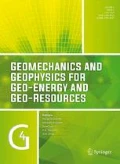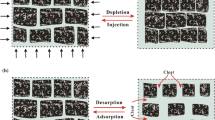Abstract
Existing studies highlight the uncertainty in the process of CO2 sequestration in deep coal seams, mainly due to the associated CO2 adsorption-induced coal matrix rearrangements. This complexity is further increased by the highly heterogeneous nature of the coal mass which causes issues in reproducing field conditions under laboratory conditions. The main objective of this study is therefore to determine the permeability behaviour in coal for CO2 flow using macro-scale reconstituted coal specimens (203 mm in diameter and 1000 mm in length), particularly under various effective stress conditions. A series of core flooding experiments was conducted on Australian brown coal, using an advanced core flooding apparatus, for a range of CO2 injection pressures and axial stresses. According to the findings, CO2 permeability decreases with increasing CO2 injection pressure, and the reduction is greater for super-critical CO2 at greater depths. The critical zone of influence for CO2 injection into a selected coal seam is greater at lower injection pressures and at shallow depths, and it reduces with increasing CO2 pressure and seam depth. CO2 storage capacity in a selected coal seam is greater at lower depths and higher CO2 injection pressures. However, the reduction of CO2 storage capacity with depth was not very significant, which is important for field CO2 sequestration projects, which normally use deep seams to store CO2.













Similar content being viewed by others
References
Day S, Fry R, Sakurovs R (2008) Swelling of Australian coals in supercritical CO2. Int J Coal Geol 74:41–52
Day S, Fry R, Sakurovs R, Weir S (2010) Swelling of coals by supercritical gases and its relationship to sorption. Energy Fuels 24:2777–2783
De Silva PNK (2013) A study of CO2 storage capacity in sedimentary rocks. PhD dissertation, Monash University, Melbourne, Australia
Hol S, Spiers CJ (2012) Competition between adsorption-induced swelling and elastic compression of coal at CO2 pressures up to 100MPa. J Mech Phys Solids 60:1862–1882
Hol S, Peach CJ, Spiers CJ (2011) Applied stress reduces the CO2 sorption capacity of coal. Int J Coal Geol 85:128–142
Jasinge D (2010) An investigation of the effect of carbon dioxide sequestration on the behaviour of brown coal. PhD dissertation, Monash University, Melbourne, Australia
Larsen JW, Flowers RA, Hall PJ, Carlson G (1997) Structural rearrangement of strained coals. Energy Fuel 11:998–1002
Liu Q, Cheng Y, Ren T, Jing H, Tu Q, Dong J (2016) Experimental observations of matrix swelling area propagation on permeability evolution using natural and reconstituted samples. J Nat Gas Sci Eng 34:680–688
Masoudian MS, Airey DW, El-Zein A (2014) Experimental investigations on the effect of CO2 on mechanics of coal. Int J Coal Geol 128:12–23
McLinden M, Klein S, Lemmon E, Peskin A (1998) REFPROP, Thermodynamic and transport properties of refrigerants and refrigerant mixtures. NIST Standard Reference Database 23, Gaithersburg, MD
Merkel A, Gensterblum Y, Krooss BM, Amann A (2015) Competitive sorption of CH4, CO2 and H2O on natural coals of different rank. Int J Coal Geol 150–151:181–192
Pan Z, Connell LD (2007) A theoretical model for gas adsorption-induced coal swelling. Int J Coal Geol 69:243–252
Pan Z, Connell LD, Camilleri M (2010) Laboratory characterisation of coal reservoir permeability for primary and enhanced coalbed methane recovery. Int J Coal Geol 82:252–261
Perera MSA, Ranjith PG, Airey DW, Choi SK (2011) Sub- and super-critical carbon dioxide flow behavior in naturally fractured black coal: An experimental study. Fuel 90:3390–3397
Ranathunga AS, Perera MSA, Ranjith PG, Ju Y, Vishal V, De Silva PNK (2015) A macro-scale experimental study of sub-and super-critical CO2 flow behaviour in Victorian brown coal. Fuel 158:864–873
Ranathunga AS, Perera MSA, Ranjith PG (2016) Super-critical carbon dioxide flow behaviour in low rank coal: A meso-scale experimental study. J CO2 Util (under review)
Siriwardane H, Haljasmaa I, McLendon R, Irdi G, Soong Y, Bromhal G (2009) Influence of carbon dioxide on coal permeability determined by pressure transient methods. Int J Coal Geol 77:109–118
Sun Y, Li Q, Yang D, Liu X (2016) Laboratory core flooding experimental systems for CO2 geosequestration: An updated review over the past decade. J Rock Mech Geotech Eng 8:113–126
Verma AK, Sirvaiya A (2016) Comparative analysis of intelligent models for prediction of Langmuir constants for CO2 adsorption of Gondwana coals in India. Geomech Geophys Geo-Energy Geo-Resour 2:97–109
Vishal V, Singh TN (2015) A laboratory investigation of permeability of coal to supercritical CO2. Geotech Geol Eng 33:1009–1016
Wang S, Elsworth D, Liu J (2013) Permeability evolution during progressive deformation of intact coal and implications for instability in underground coal seams. Int J Rock Mech Min Sci 58:34–45
Wang Y, Liu S, Elsworth D (2015) Laboratory investigations of gas flow behaviors in tight anthracite and evaluation of different pulse-decay methods on permeability estimation. Int J Coal Geol 149:118–128
White CM, Smith DH, Jones KL, Goodman AL, Jikich SA, LaCount RB, DuBose SB, Ozdemir E, Morsi BI, Schroeder KT (2005) Sequestration of carbon dioxide in coal with enhanced coalbed methane recovery: a review. Energy Fuels 19:659–724
Xie J, Gao M, Yu B, Zhang R, Jin W (2015) Coal permeability model on the effect of gas extraction within effective influence zone. Geomech Geophys Geo-Energy Geo-Resour 1:15–27
Acknowledgments
The authors wish to express their appreciation for the funding provided by the Australian Research Council (DE130100124).
Author information
Authors and Affiliations
Corresponding author
Additional information
M. S. A. Perera is an adjuct research fellow in Monash University, Melbourne, Australia.
Rights and permissions
About this article
Cite this article
Ranathunga, A.S., Perera, M.S.A., Ranjith, P.G. et al. A macro-scale view of the influence of effective stress on carbon dioxide flow behaviour in coal: an experimental study. Geomech. Geophys. Geo-energ. Geo-resour. 3, 13–28 (2017). https://doi.org/10.1007/s40948-016-0042-2
Received:
Accepted:
Published:
Issue Date:
DOI: https://doi.org/10.1007/s40948-016-0042-2




